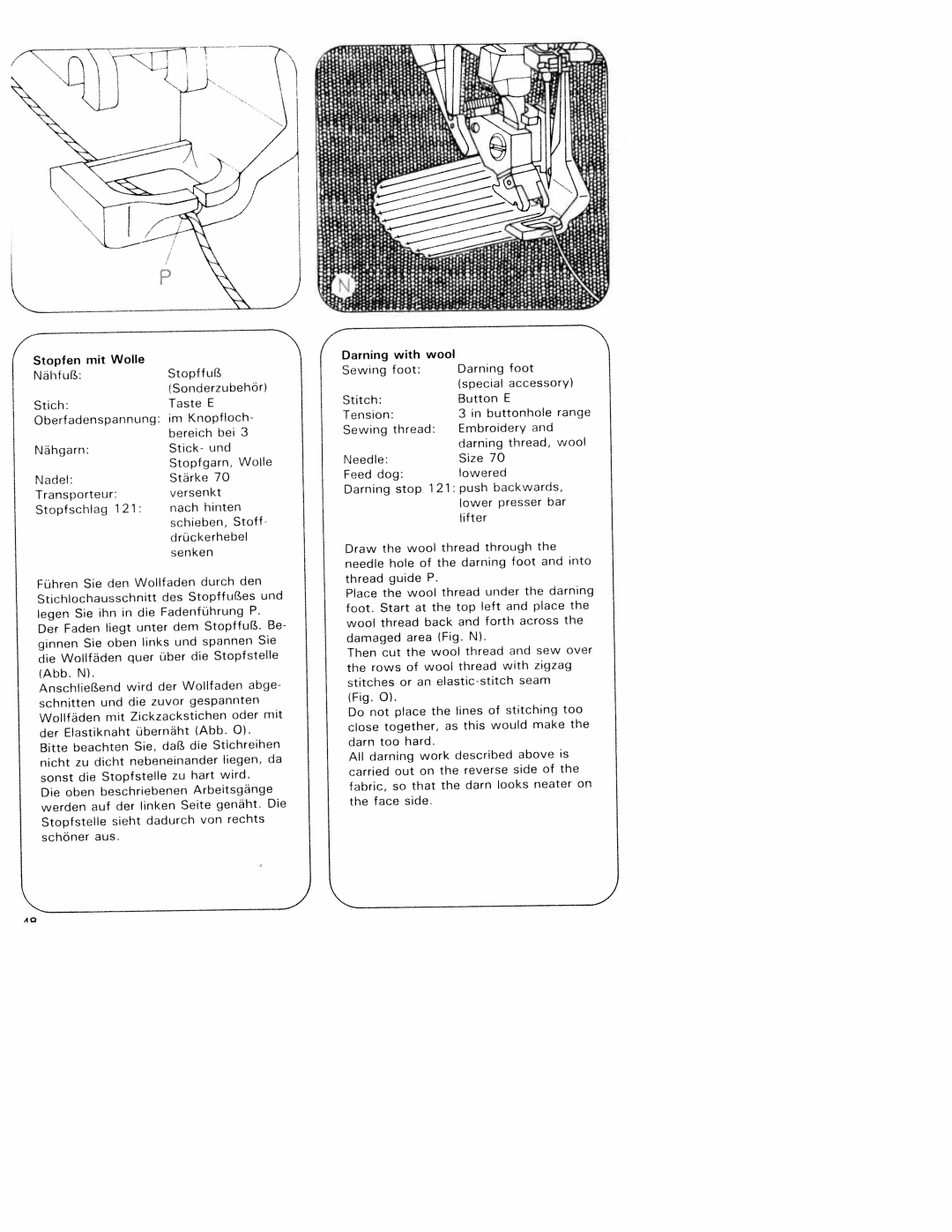
Stopfen mit Wolle NahfuR:
StopffuR |
Sonderzubehdr) |
4 | with | wool |
| |
Darnmg | foot | |||
Sewing | foot: | Darning | ||
accessory) | ||||
|
| (special |
Stich: Oberfadenspannung:
N ähgarn:
Nadel:
Transporteur:
Stopfschlag 121:
Taste E |
|
|
mm Knopfloch | ||
hereich | bei | 3 |
Stick | md |
|
Stopfgarn, | Wote | |
Stärke | 70 |
|
verse n k |
| |
nach hinten | ||
schieben, | Stoff | |
drbckerhebel | ||
Stitch: |
|
|
Tension: |
| |
Sewing | thread: | |
Needle: |
|
|
Feed dog: |
| |
Darning | stop | 121 |
Button F |
| |
3 in buttonhole | range | |
| ||
Embroidery and |
| |
darning thread, | wool | |
Size 70 |
| |
lowered |
| |
push | backwards, | |
lower | presser bar | |
lifter |
|
|
senken |
Draw the wool | thread through | the | into |
needle hole of | the darning foot | and |
Fdhren Sie den Woilfaden | durch den | und | |||||||||||
Stichlochausschnitt | des | Stopffuttes | |||||||||||
| |||||||||||||
Fadenfdhrung P. |
| ||||||||||||
legen | Sie | ihn in | die |
| |||||||||
Der Faden | liegi | unter | dem |
|
| . | Be | ||||||
Stopfful |
| ||||||||||||
ginnen Sie oben |
| inks | und | spannen Sic | |||||||||
die Woflfäden | quer | dber | die Stopfstelle | ||||||||||
lAhb. | N). |
| wird | der Wollfaden abge | |||||||||
AnschheRend | |||||||||||||
schnitten | und | die | zuvor | gespannten | mit | ||||||||
Woflfäden | mit | Zickzackstichen | oder | ||||||||||
| übernäht | )Abb. | 0). |
| |||||||||
der Elastiknaht |
| ||||||||||||
Bitte | beachten Sic, | dalt, | die Stichreihen | ||||||||||
nicht | zu dicht | nebeneinander | liegen, | da | |||||||||
sonst | die | Stopfste)le | zu | hart | wird, |
| |||||||
Die ohen | beschriebenen | Arbeitsgdnge | |||||||||||
|
|
| . | Die | |||||||||
werden auf der |
|
|
|
|
|
|
| ||||||
linken Seite gendht |
| ||||||||||||
Stopfste))e sieht | dadurch | von | rechts | ||||||||||
|
|
|
|
|
|
|
| ||||||
schdner aus. |
|
|
|
|
|
|
|
|
|
| |||
thread | guide P. |
|
|
| under the darning | ||||||||
Place | the wool | thread | |||||||||||
foot. | Start at | the | top left | and | place | the | |||||||
wool | thread | back | and | forth across |
| the | |||||||
damaged area |
| (Fig. | N). |
| and | sew | over | ||||||
Then | cut the | wool | thread | ||||||||||
the rows of | wool | thread | with | zigzag | |||||||||
stitches or an | elastic stitch seam |
|
| ||||||||||
(Fig. | 0). |
| the | lines | of | stitching too | |||||||
Do not | place | ||||||||||||
close | together, | as | this | would | make | the | |||||||
darn | too hard. |
| described above | is | |||||||||
All darning | work | ||||||||||||
| reverse side of | the | |||||||||||
carried | out | on | the | ||||||||||
fabric, | so that | the | darn looks | neater on | |||||||||
the face side. |
|
|
|
|
|
|
|
|
| ||||
